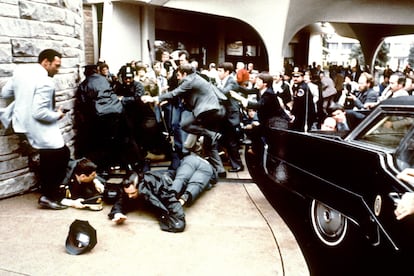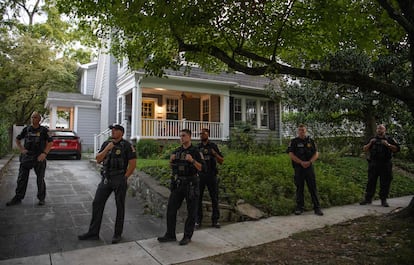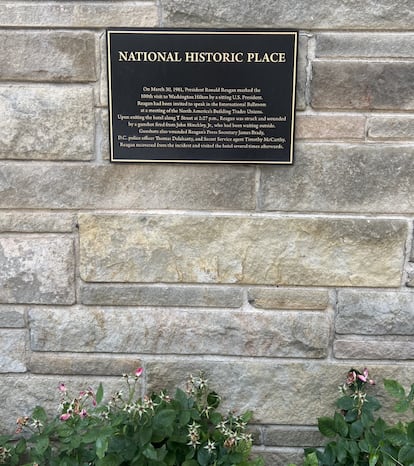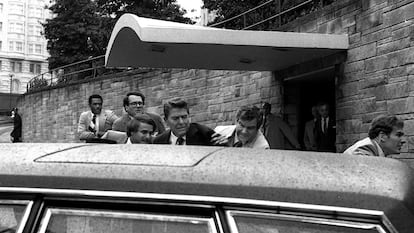The assassination attempt on Ronald Reagan that changed the world
Experts say the foiled plot helped the Republican leader secure a second term and go on to lead a conservative revolution. Meanwhile, John Hinckley, the man who shot him, has been unconditionally released and is planning a music tour

The Hilton, an imposing double-arched brutalist hotel, is one of the most prominent attractions in the great political theme park that is the city of Washington DC. A plaque at the hotel indicates that at 2.27pm on March 30, 1981, during “the 100th visit by a president,” a disturbed man named John Hinckley, Jr. shot US President Ronald Reagan with a 22-caliber revolver loaded with explosive charges designed to explode on contact. Hinckley believed the attack would impress actress Jodie Foster.

Reagan, a former Hollywood actor, had just spoken before an audience of construction businessmen at the Hilton’s International Ballroom, one of the most famous event spaces in the city, where the White House Correspondents’ Dinner is held every year. Reagan exited the building on T Street and headed towards his limousine, where reporters and admirers were waiting for him. Hidden among the crowd was Hinckley, a ruddy boy who blended in so well that nobody realized he had the president in his sights. He shot at Reagan six times. One of the bullets ricocheted off the limousine and hit the Republican president under his left armpit. “What the hell was that!” he yelled. White House press secretary James Brady, Secret Service agent Tim McCarthy and local police officer Thomas Delahanty were also hit. The three survived, but Brady was permanently disabled. A medical examiner ruled that his death in 2014 was a homicide, caused by the gunshot wound, but federal authorities did not press charges against Hinckley.
On Wednesday, 41 years after the assassination attempt, Hinckley is due to be unconditionally released. The release marks a new chapter in one of the most traumatic episodes in recent US presidential history. The judge’s decision was celebrated by Hinckley on Twitter: “A big thank you to everyone who helped me get unconditional release. What a long strange trip it has been. Now it’s time to rock and roll.”
And Hinckley means “rock and roll” in the most literal sense: at 67 years of age, he has set his sights on a career in music. He has a tour planned and his July 8 concert at a hotel in Brooklyn has already sold out.
A big thank you to everyone who helped me get my unconditional release. What a long strange trip it has been. Now it’s time to rock and roll.
— John Hinckley (@JohnHinckley20) June 1, 2022
His “long strange trip” can be summed up like this: Hinckley was charged with 13 offenses, but in 1982, he was found not guilty by reason of insanity. In a decision that caused widespread controversy, he was sent to St. Elizabeth’s psychiatric hospital in Washington, where he remained until 2016, when he was released on the condition that he would live with his mother in Williamsburg, Virginia. He was also prohibited from contacting Jodie Foster and the victims of the assassination attempt, and their families. Two years later, he was allowed to leave his mother’s home, and in 2020, a judge gave him permission to share his songs with the world. Hinckley has a YouTube channel and a Spotify list with around 30 songs, mostly with guitar and vocals. After selling out his concert in Brooklyn, the 67-year-old has announced more dates for the “John Hinckley Redemption Tour.”
Hinckley thought killing Reagan would impress actress Jodie Foster, then an 18-year-old star who had decided to take a break from the whirlwind of Hollywood to study at Yale University in New Haven, Connecticut. The would-be assassin was set on following her to New Haven, taking the four-day bus from Los Angeles. He had become obsessed with her in the movie Taxi Driver, in which Robert De Niro plays a taxi driver who plans to assassinate a presidential candidate. Hinckley decided to stop in Washington and, after noticing that Reagan’s schedule had been published in a local newspaper, changed his plan.

That March 30 was a wet and cloudy day. Reagan had only been in office for 69 days, and things were not going well for him. The honeymoon period wasn’t over yet, but his approval ratings were already lower than what he expected. “The assassination attempt silenced criticism of his administration at a critical early point in his term,” explains H. W. Brands, author of the biography Reagan: The Life (2015), in an email. “The good humor he exhibited during his recovery [he spent only 12 days in the hospital] convinced many skeptics. Some of his followers believed that God had forgiven him to allow him to finish his work. And it is possible that Reagan himself thought so too.”

On the 30th anniversary of the assassination attempt, journalist Del Quentin Wilber published Rawhide Down (2011), a thorough investigation full of revelations about what happened that day. The book is written in the style of true crime, and its title is a reference to the secret service codename given to Reagan, “Rawhide” – Joe Biden’s codename is “Celtic” and Donald Trump’s was “Mogul.” It reaches two important conclusions. Firstly, it argues that Reagan became the first president since Eisenhower to serve two terms because of the way he and his team handled the assassination attempt. And secondly, the White House did not reveal the seriousness of Reagan’s injuries.
“He was a 70-year-old man and they didn’t want to give the impression of weakness, even though the bullet lodged near the heart and he lost more than half his blood,” Wilber tells EL PAÍS by phone. “Still, he insisted on going into the hospital on his own two feet. And that’s when he passed out. They couldn’t detect his blood pressure because it was so low. If they had gone to the White House and not straight to the George Washington [hospital], he would have died. Just as the assassination of JFK changed history, the assassination attempt on Reagan changed him and his view of things, and ultimately changed the world.”
Wilber points out that the United States was still reeling from the assassination of Robert Kennedy and Martin Luther King in 1968, as well as the attempt on Democratic candidate George Wallace’s life in 1972. What’s more, only three months earlier, a lunatic had killed John Lennon, and another tried to kill Pope John Paul II two months later.
It’s tempting to draw parallels between then and now. It is not just that the current hearings on the siege of the US Capitol are reminiscent of the hearings on the Iran-Contra affair, a political scandal that decimated Reagan’s popularity in 1987 and saw him nicknamed the “Teflon President.” (“Although he handled that crisis with much greater intelligence than Trump,” says Joe Rodota, who worked in the White House at that time.) Fears of assassinations are once again building up. Just a week ago, a man was arrested near the home of Supreme Court Justice Brett Kavanaugh, who he was planning on killing. Another man murdered a judge in Wisconsin and had a list of future victims that included the Democratic governors of that state and Michigan, as well as Republican politician, Mitch McConnell, who is the Senate minority leader.

In Reagan’s diaries, the entry for March 30 is a summary of his time in the hospital. “Getting shot hurts,” he wrote, clearly after the date. “I opened my eyes once to find Nancy [Reagan, his wife] there. I pray I’ll never face a day when she isn’t there. Of all the ways God has blessed me giving her to me is the greatest and beyond anything I can ever hope to deserve.” That day did not arrive, the first lady outlived the president by 12 years. Reagan died in 2004, after living with Alzheimer’s disease for 12 years.
In his diaries (or, at least, in the selection of these made by the historian Douglas Brinkley in 2007), Hinckley appears five times, always in passing. For example, in the entry for June 22, 1982, Reagan recounts: “Met 125 candidates for Cong. & had photo with each. I hope they make it. I wonder what it would be like to have a Repub. House & Senate? Yesterday Hinckley was found innocent by reason of insanity. Quite an uproar has been created.”

When the decision to release Hinckley was announced last October, Reagan’s daughter Patti Davis wrote a column in The Washington Post to oppose the move: “People’s memories have faded. That burst of gunfire outside the Washington Hilton was a long time ago. I have friends who weren’t even born then. But for me, for my family, for Foster, the memory of that day will never fade. In my mind’s eye, I will always picture Hinckley’s cold eyes as he blew open White House press secretary Jim Brady’s head, as he wounded Secret Service Special Agent Tim McCarthy and Metropolitan Police Department Officer Thomas Delahanty. I will always picture my father being shoved into the limousine after a shot struck his lung and nearly grazed his heart.”

At the Washington Hilton, last Friday, the assassination attempt also seems to have faded from memory; it was impossible to find anyone who directly remembered what happened. But the corner where Reagan was shot in 1981 – a scene of which there are multiple photographs (two photographers and three cameramen were present) – has not changed much, except for the plaque and flower bed that were placed there later. The flower bed is there, explained a bellman, to stop people from gloating in the spot where Hinckley shot Reagan. That fateful day changed the course for Reagan, who would go on to win a second term and lead a conservative revolution that would change America (and the world) forever.
Tu suscripción se está usando en otro dispositivo
¿Quieres añadir otro usuario a tu suscripción?
Si continúas leyendo en este dispositivo, no se podrá leer en el otro.
FlechaTu suscripción se está usando en otro dispositivo y solo puedes acceder a EL PAÍS desde un dispositivo a la vez.
Si quieres compartir tu cuenta, cambia tu suscripción a la modalidad Premium, así podrás añadir otro usuario. Cada uno accederá con su propia cuenta de email, lo que os permitirá personalizar vuestra experiencia en EL PAÍS.
¿Tienes una suscripción de empresa? Accede aquí para contratar más cuentas.
En el caso de no saber quién está usando tu cuenta, te recomendamos cambiar tu contraseña aquí.
Si decides continuar compartiendo tu cuenta, este mensaje se mostrará en tu dispositivo y en el de la otra persona que está usando tu cuenta de forma indefinida, afectando a tu experiencia de lectura. Puedes consultar aquí los términos y condiciones de la suscripción digital.
More information
Archived In
Últimas noticias
ChatGPT fails the test: This is how it endangers the lives of minors
The late consecration of women artists in their 90s
The Florida Keys tourist paradise is besieged by immigration agents: ‘We’ve never seen anything like this’
The latest scam on WhatsApp behind the legal dream: using immigration status as bait
Most viewed
- Families demand repatriation of bodies of Colombians who died in Ukraine: ‘This war is a slaughterhouse for foreigners’
- The low-cost creative revolution: How technology is making art accessible to everyone
- Liset Menéndez de la Prida, neuroscientist: ‘It’s not normal to constantly seek pleasure; it’s important to be bored, to be calm’
- Christian Louboutin: ‘Young people don’t want to be like their parents. And if their parents wear sneakers, they’re going to look for something else’
- ‘El Limones’ and the growing union disguise of Mexican organized crime










































